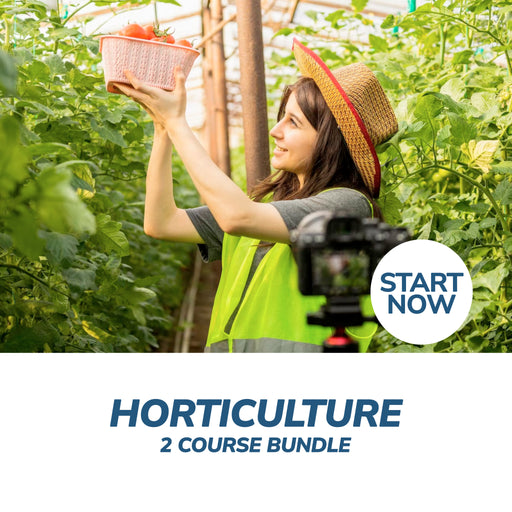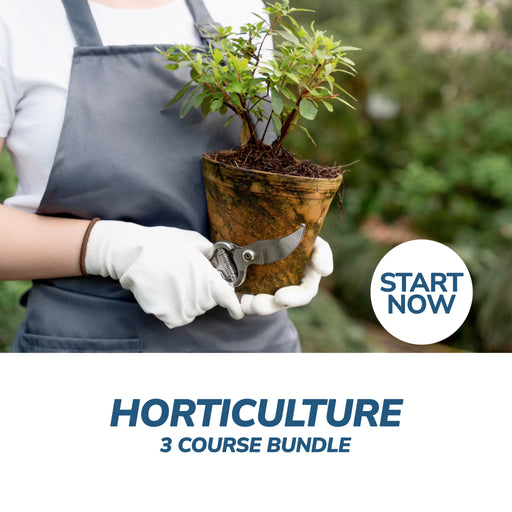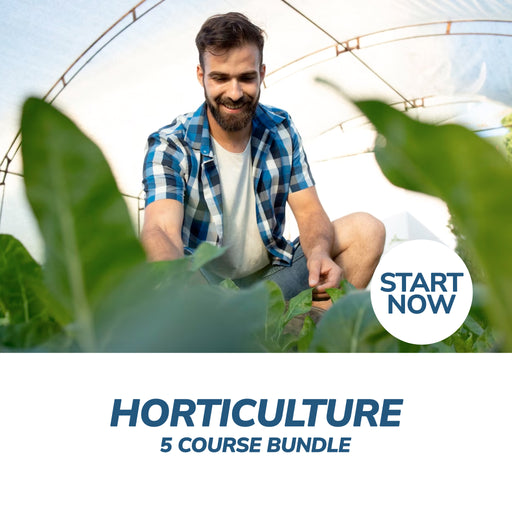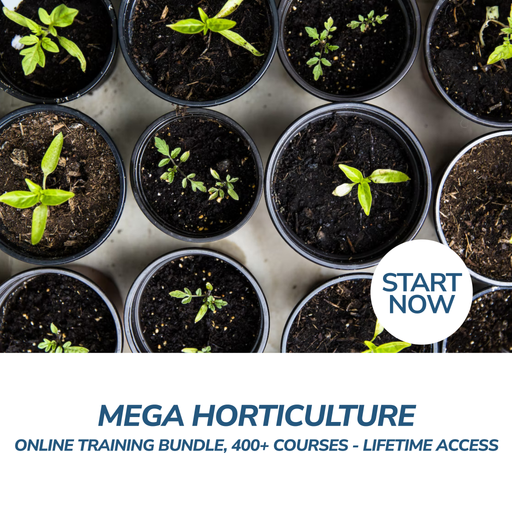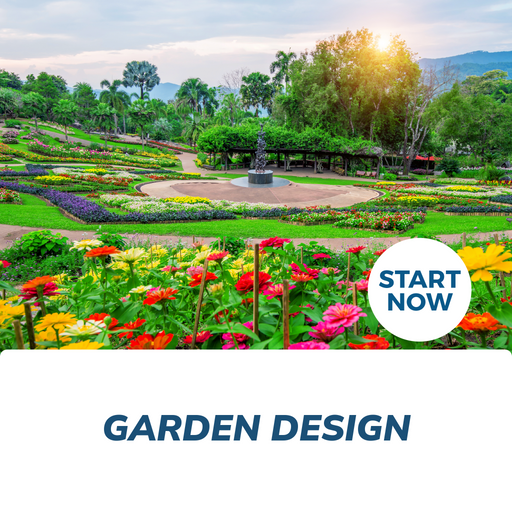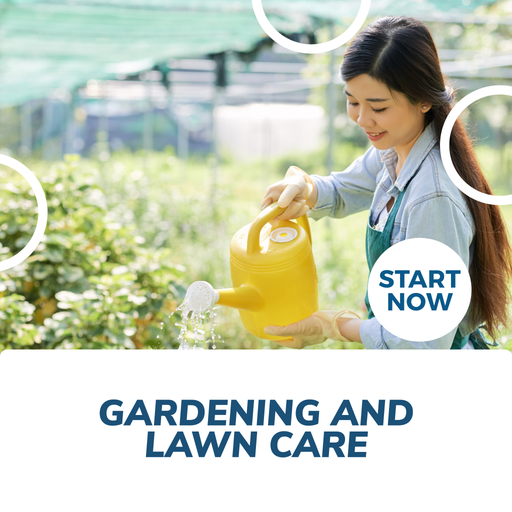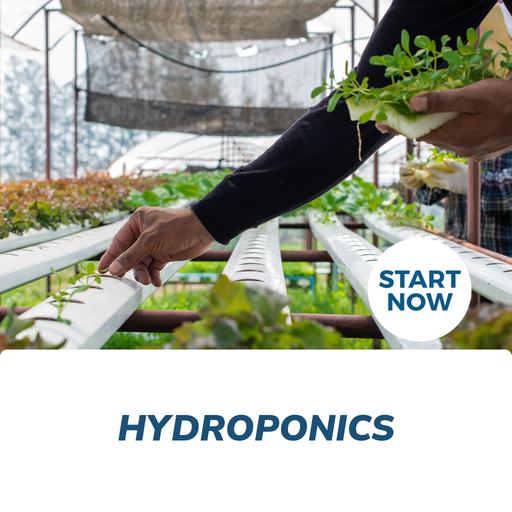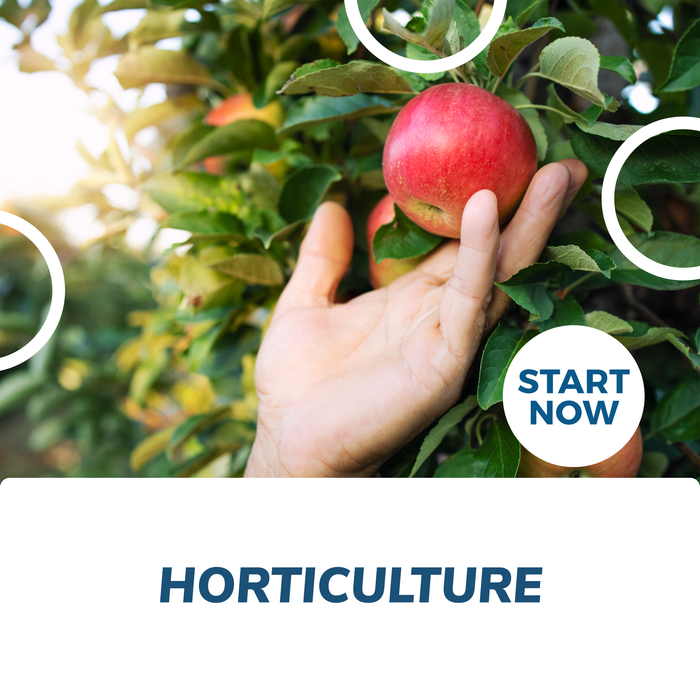
About This Course
Enjoy these Benefits and Discover the Benefits of Sustainable Plant Production Today!
|
|
Study Horticulture Online Course and Gain Skills and Knowledge Needed to Better Understand the Growing of Plants
Our Horticulture Online Course will discuss Horticulture, the technology and art of sustainable development, production of plants. We will discuss the role of horticulture and its contribution to the beauty, sustainability and relaxation of our environment and human existence.
Plant growing technology, also known as agronomy, is the technology of production of food plants, cereals, fodder, grasses and fibres by the world's leading companies and consists of production, breeding, and marketing.
The production and use of varieties of seeds and vegetables allow us to have a healthy and balanced diet in daily life. Flowers and ornamental flowers enrich our homes and groups and contribute to our well-being.
A career in horticulture for any prospective student can open up through a horticulture certificate. Our horticulture course provides graduate students the prospect of future employment in environmental sciences, food production, or as gardener and landscape artist.
How will the Online Horticulture Course be delivered?
Courses are accessed online via our learning management system by any device including PC, tablet or Smart Phone. Upon enrolment an automated welcome email will be sent to you (please check your junk email inbox if not received as this is an automated email), in order for you to access your online course, which is Available 24/7 on any computer or smart mobile device.
Learn how to become an expert in Horticulture
Written and developed by leading Horticulture experts
Unlimited, lifetime access to online course
Certificate of completion awarded with passing score for the online assessment
Study at your own pace with no rigid class timetables, 24/7 from any computer or smart device
Online Horticulture Course - Requirements
The Online Horticulture Course is delivered 100 percent online 24/7 and only takes 20 hours of study to complete.
To successfully complete this course, a student must:
● Have access to the internet and the necessary technical skills to navigate the online learning resources
● Have access to any mobile device with internet connectivity (laptop, desktop, tablet)
● Be a self-directed learner
● Possess sound language and literacy skills
Features of Our Horticulture Course
Students will take up environmental studies, landscape architecture, plant propagation, integrated pest management, turf management, plant breeding, pesticide safety, ecological design, urban agriculture, plant pathology and much more before they enter the horticulture industry.
Our horticulture course is designed to provide ample professional development. The average annual salary of a horticulturist is $42,169 in the USA. The admission requirements for this horticulture course is just the application fee. So anyone can learn crop sciences from our certificate courses.
Our horticulture degree programs can also help you create a sustainable garden at your home with home horticulture. You can have your own garden design for vegetable production after getting out certificate in horticulture.
Our master gardener program imparts the knowledge and skills required to create a beautiful garden at your home. The gardening program can add valuable knowledge in turn helping you getting the best out of your garden.
A degree of certification in the horticulture program can go a long way. The horticulture course also provides career resources to students. There is also the option for a summer course or a masters degree.
No need to worry about campus life as the course is online and we are one of the best online schools for learning horticulture.
You can apply for financial aid, ask for transferring credits and also take elective courses to study only the area of your interest. We also have adjunct faculty in case any student needs extra classes.
Quick Course Facts
Course content is structured for easy comprehension
Approximately 20 hours of study is needed to complete the course
Registered students gain unrestricted access to the Online Horticulture Course
All course material is available online 24/7 and can be accessed using any device
Study online from anywhere in your own time at your own pace
All students who complete the course will be awarded with a certificate of completion
Horticulture Online Certificate Outline
Module 1: Horticulture
In this lesson, we will go over horticulture fundamentals, which is the art and science of creating and sustainably cultivating plants. Horticulture is an agricultural branch that deals with gardens, commodities, landscaping, and ornamental plants.
History of Horticulture
Horticulture was initially introduced between 7,000 and 10,000 BCE by cultures in southwestern and eastern Asia. Horticulture is a practice developed in the Fertile Crescent, including modern-day Iraq, Syria, Jordan, Iran, and Turkey.
Father of American Horticulture
Liberty Hyde Bailey, the Society for Horticultural Science's first President, was a polymath. He is known as the "Father of American Horticulture" and the "Dean of Horticulture" worldwide.
Role of a Horticulturist
Horticulture encompasses the study of plant physiology and propagation. Horticulturists use their extensive understanding of botany, plant science, and soil science to work in landscape design and crop management.
Salary and Career Outlook
Horticulturists can also work as agricultural worker supervisors, which pays $48,280 on average per year. They could also work as landscapers, assisting with the design and maintenance of gardens and grounds.
Module 2: Anatomy and Plant Processes
We will go through the anatomical components of plants and the processes that allow them to survive in this unit.
Basic Anatomical Components
The study of plant form, structure, and size is known as plant anatomy. It is a branch of botany that investigates a plant's functional and structural components.
Roots
The roots of a plant assist it in remaining erect. Plants use their roots to absorb water, minerals, and other nutrients from the soil. The roots supply the plant with everything it requires to produce nourishment. While the roots of certain aquatic plants float, the majority of roots grow underground in the soil. Some root systems allow the plant to climb by attaching to a vertical surface.
Stems
Plant stems provide two functions. They provide water and minerals to the plant's above-ground elements, often the buds, leaves, and flowers.
Seeds and Flowers
A seed-producing plant's reproductive component is the flower. Male and female cells join to make seeds in flowers.
Photosynthesis
Photosynthesis is the process through which green plants transform solar energy into chemical energy. Green plants employ light energy during photosynthesis to convert carbon dioxide, water, and minerals into oxygen and energy-rich living compounds.
Respiration
Sugars are oxidized by plant respiration to provide energy to the plant. In many ways, respiration is the polar opposite of photosynthesis. Plants must produce their food in order to thrive in their natural habitat.
Osmosis
Through a semipermeable membrane, molecules flow from a higher solute concentration zone to a lower concentration zone. The osmotic process can be slowed or stopped by increasing hydrostatic pressure on the high-concentration side of the membrane.
Module 3: Soil Science
We will talk about soil science and how soils form in Module 3. We also go through how to test for crucial soil nutrients.
Soil Basics
Most forms of soil take 500 years or more to develop from rocks on average. When rocks are broken down into their constituent parts, the soil is formed.
Sandy Soil
Sandy soil consists of small, weathered rock fragments created by the dissolution or fragmentation of limestones, granite, and quartz. Sandy soils are among the most difficult to grow plants in.
Loamy Soil
Loam is another form of soil. Sand, silt, and clay make up the mixture. It exemplifies the best qualities of each of its constituents.
Silt Soil
Silt is made up of rock and mineral particles that are smaller than sand but larger than clay. The soil's thin, smooth texture holds water better than sand.
Clay Soil
Of the two soil types, clay has the tiniest particles. This soil's particles are compact and close together, with little to no space between them.
Plant Nutrition
Plants, like animals, require nutrients. They are required for germination, development, and damage resistance. Nutrient availability significantly impacts plant growth and development; thus, knowing the dynamics of nutrient absorption, transport, assimilation, and biological interaction is crucial for enhancing agricultural plant production.
Macronutrients and Micronutrients
Macronutrients are macronutrients, which are vital compounds that plants require in large quantities. Essential macronutrients are absorbed in large amounts by plants, while supplemental micronutrients are consumed in lower amounts. Each of these nutrients serves a distinct purpose in the nutrition of the plant.
Testing Soil
Analyze your soil and make necessary changes to create the best possible environment for plants to thrive in.
Testing Procedures
Testing your soil is the only method to find out if it is suited for your plants. Evaluating your soil is an uncomplicated and straightforward process. Do-it-yourself kits and professional labs are the two options for determining the condition of your soil.
Common Soil Issues
Poor plant performance is frequently caused by unhealthy soil. Correct any soil inadequacies as much as possible before planting.
Soil Erosion
Soil erosion refers to the loss of the top layer of soil. Erosion is widespread on slopes and in regions where soils are exposed.
Composting
Composting is an aerobic process that helps soil and plants convert biodegradable items like twigs and leftover food into fertilizer. By guaranteeing that bacteria, fungus, and other decomposers (such as worms, sowbugs, and nematodes) may thrive in that environment, composting speeds up the breakdown process.
Module 4: Floriculture
We will talk about floriculture's specific niche and the obstacles that horticulturists who work with ornamental plants encounter.
Floriculture
Aesthetic, decorative, and ornamental horticulture are the most common types of floriculture. Despite being primarily grown in structures, many flowers and potted plants are cultivated outside nurseries or crop fields in temperate countries.
Ornamental Plants
Ornamental plants, as their name implies, are ornamental. By providing a beautiful, tranquil setting, they can have a considerable impact on people's well-being.
Bedding and Garden Plants
Plants grown in pots or flats in a greenhouse or similar structure are bedding and garden plants. They will be transplanted to a flower garden, window box, hanging basket, or another outdoor container once they are ready.
Potted Plants
"potted plants" refers to plants grown and cultivated in containers rather than in the ground. Potted plants are ideal for smaller spaces or for more delicate blooms that are susceptible to environmental factors.
Annual Flowers
True annuals are plants that grow, blossom, distribute seeds, and die simultaneously. The end goal is for them to reproduce, which is fantastic news for farmers.
Perennial Flowers
Different sorts of care and upkeep are required for perennials. Some people are harsh and laid-back, as though they wish to be ignored. Others may need more frequent pruning and division to maintain their vigor and cleanliness.
Module 5: Arboriculture
We will describe arboriculture and how to care for plants that fit into this category in Module 5. We will also talk about arboriculturists' roles in various settings and work environments.
Definition of Arboriculture
An arboriculturist is a professional who has the knowledge and technical abilities to maintain trees, shrubs, hedgerows, and vines. An arboriculturist, despite dealing primarily with trees, is frequently well-versed in a variety of fields.
Trees
Arboriculturists are usually interested in trees, as previously noted. Expertise is required for both planting and maintaining a tree.
Shrubs
Shrubs are another type that arboriculturists may be interested in. Because shrubs are so dense and low to the ground, detecting if they are not adequately cared for is simple.
Vines
Arboriculturists are also responsible for the upkeep of vines. Most vines develop by adhering to the structures that surround them. It is what they are made for: climbing up a tree or a wall.
Responsibilities of an Arboriculturist
Depending on their specific expertise and workplaces, arboriculturists may be in charge of a variety of responsibilities.
Module 6: Landscape Horticulture
The first part of this landscape horticulture section will cover lawn design concepts and best practices. We will also review techniques to take care of established lawns.
Lawn Design
Designing a lawn entails tastefully placing plants, fencing, furniture, and other components in an outdoor space to create an outdoor setting.
Mapping
It is preferable first to sketch out your thoughts on a smaller scale. Make a basic sketch of the region you will be working on.
Atmosphere
Your lawn might be formal, semi-formal, or informal in design. The asymmetrical arrangement, with boundaries and defined places for distinct parts, is more formal.
Functionality
Choose a lawn style and leave the rest on your client's lawn. A functional lawn connects lush green turfs with vibrant flower beds for a more cohesive look.
Creativity
You may always experiment with different ideas when it comes to planning laws.
Types of Grass
The type of grass in your area has a significant impact on landscape gardening and lawn planning methods. Knowing the region and season in which your lawn must grow allows you to select the grass that best matches your clients' lawn.
Feeding Established Lawns
Nutrients must be provided to lawns regularly. Various grasses have different nutritional requirements, so keep that in mind while doing soil testing.
Watering Lawns
Keep the following fundamental elements in mind while evaluating a client's irrigation systems and watering methods. Grass can be destroyed by either too little or too much water. The nutrients are washed away by too much water.
Safe Mowing
Grass mowing is an essential element of lawn care. Mowing the grass strategically not only beautifies and trims it but also keeps it looking good.
Module 7: Indoor Plants
Welcome to the indoor plant's module. We will talk about the characteristics of indoor plant settings and what plants need to grow in this unit.
Ideal Environment
When it comes to gardening, indoor surroundings differ significantly from outdoor environments. The presence of a regulated environment in the case of indoor plants is one clear difference.
Light
Light is an essential aspect of plant growth since it aids flowering and photosynthesis. Different plants demand different things.
Temperature
The majority of indoor plants are tropical or subtropical. Therefore, they prefer warmer temperatures. The appropriate temperature promotes plant germination while also allowing for proper respiration and transpiration.
Humidity
Humidity is essential for healthy plant growth. The amount of moisture in the air is measured by relative humidity (RH).
Container Material
Plant containers and pots are available in a wide range of materials and styles. Terracotta, clay, plastic, and ceramic pots can all be found in most home improvement stores.
Container Size
Plants require space to grow. Enough room allows the roots to extend and the leaves to expand. The rate of plant development determines the appropriate container size.
Module 8: Plant Species
We will go through different types of species and how they can affect the local ecology in this section of the course. We will also talk about the threats posed by invasive species.
Native Plants
Native plant species have lived in a region for a long time without being influenced by humans. Native plants do not require human intervention to spread and thrive in a given location.
Exotic Plants
Exotic plant species are non-native species that do not occur natively in a location but are introduced by humans intentionally or accidentally.
Invasive Plants
Exotic plant species that invade and threaten a specific region are known as invasive plant species. They can overrun local flora quickly, posing a threat to biodiversity.
Module 9: Propagation
The sexual propagation cycle of plants will be discussed in Module 9. You will also learn about cuttings, seeds, and grafting in this unit.
Sexual Propagation Cycle
While reproducing, all plants alternate generations. This means that they must grow as one form to create a second form to reproduce.
Preparing Seed Beds and Trays
When starting a seedbed or tray to produce vegetation or start a garden, keep a few things in mind. The scale will also have an impact on how plants are organized and placed.
Storing Seeds
There are numerous strategies to ensure that seeds will successfully germinate and thrive when stored for later planting. Under the right conditions, seeds can be kept for several years.
Cuttings
In rare cases, cut portions of plants might be used instead of seeds for propagation. The cutting will grow to be the same plant as the one from which it was taken.
Grafts
Grafting is a technique for combining two plants of similar species. One plant's root is taken, while another's upper portion is taken.
Module 10: Amenity Horticulture
This module will cover amenity horticulture, which uses flora and verdure for decoration and pleasure. A discussion of main plant groups and critical concerns when working with decorative plants will be included.
Amenity Horticulture
People can see amenity horticulture whenever they walk into a well-decorated patio area, courtyard, or public garden. It is the skill of arranging plants and flowers so that they are attractive to the eye or the environment.
Key Plant Groups
Four main plant groups survive on land, according to science. Flowering plants (angiosperms), ferns (pteridophytes), cone-growing plants (gymnosperms), and mosses (bryophytes) are all examples of angiosperms.
Hardiness
In order to do amenity horticulture, you must have a thorough understanding of plant resistance and hardiness. The plant's hardiness is crucial in determining whether it satisfies your clients' expectations and is suitable for the environment.
Maintenance
Even if you do not intend to maintain plants, you should be aware of the types of maintenance that will be required. When designing their maintenance routines, landscaping companies or clients may seek your advice.
Appearance
The design's overall appearance and aesthetics must be prioritized. Various plants have different meanings.
Budget
A budget is an unavoidable consideration. You will be limited to working within the budget of your employer or client.
Functionality
The importance of functionality cannot be stressed enough. Even if the outcome is not to be used functionally, an amenity horticulturist must know what will work on a functional level.
Module 11: Fertilizer
We will discuss fertilizer in this session and how it may be used to boost plant health. We will also go through the advantages of composting.
Feeding Plants
The chemical breakdown of once-living organisms into their fundamental parts is known as decay. Beneficial microbes help to speed up this process.
Organic Fertilizer
"Organic" fertilizers contain minerals and nutrients that are produced naturally in outdoor processes. Manure, compost, and bone meal are just a few examples.
Chemical Fertilizer
Chemical fertilizers are artificial mixtures of the nutrients that plants require. They are less safe than organic fertilizers and, over time, harm the soil. They are popular, though, since they produce speedier results.
Composting
Composting is the process of collecting organic matter that is ready to degrade. The decomposition process can be accelerated by combining everything in a composter or compost pile.
Benefits of Composting
Composting is beneficial to all types of plants as well as the environment. Food waste represents a significant amount of trash that could be repurposed for a highly beneficial outcome.
Module 12: Planting and Potting
This potting and planting class will go through the best techniques for keeping plants alive in various situations.
Planting in Containers
Planting in pots or containers is a great way to bring life to a space. To accomplish it correctly, make sure you choose the perfect container for the plant in question.
Fertilizer
Plant food is indicated to help the plant's rate of growth and health by increasing the microbial content. Before planting anything, a layer of fertilizer should be applied to the container. Organic matter is required to nutrition a new plant's seed or the roots of a transplanted plant.
Transplanting
A plant is transplanted when it is relocated from one site to another. Pay close attention to the roots before transplanting. Digging out the plant should be done with care and gentleness, especially if it is small. Roots can regrow if they are lost, but it will take time.
Staking
Plants may require support to ensure they do not topple over when establishing themselves in their new surroundings. A healthy plant may droop, but this should be adjusted to receive the maximum amount of sunshine while also increasing blood flow throughout its cells.
Caring for Newly Transplanted Plants
Growing a plant from a seed differs slightly from caring for one that has recently been transplanted. During the first few days after transplantation, watering should be done more often.
Feeding
Because a potted plant is locked in one mound of soil, the feeding strategy must be carefully examined to avoid disrupting the well-controlled environment. Liquid foods with high nitrogen concentrations are recommended for a rapid feed and to avoid acid accumulation.
Watering
Plants in pots should be watered once or twice a week. It is critical to determine the proper amount of water that can reach the roots.
When to Fertilize
Different plants require different quantities of fertilizer, but they all require multiple applications throughout the growing season.
Maintenance: Cutting Back
Cutting back is a procedure that involves cutting the plant's stem with shears while it is still growing. This boosts the stem's strength, allowing it to support larger blooms or fruits.
Maintenance: Pinching
Pinching is similar to cutting back. However, it is done with the fingers instead of a knife. It has been customarily conducted every two to three weeks on smaller plants.
Maintenance: Deadheading
The removal of fading and dead flowers is known as deadheading. When a flower dies, its seeds are dispersed. Some plants that could have produced additional flowers will not bloom again that season due to this. More bud and blossom development can be triggered by removing the fading flowers.
Module 13: Threats to Plant Health
We will talk about disease and pests as well as other hazards to plant health in Module 13. We will also look at some of the environmental factors that can harm plants.
Types of Threats
Disease and environmental factors are the most common hazards to plant health. Bacterial, viral, and fungal infections are the most common causes of these disorders.
Insects and Pests
Insects naturally feed on plants to survive. Plant sap is a food source for the larvae of these insects. Butterflies, moths, and beetles are insects that live and feed on different portions of plants. Flowers, leaves, roots, and stems are the most commonly attacked by pests and insects.
Defining Disease
Plant disease is defined as a disorder that affects a plant's development and natural growth. Nonliving and living agents also contribute to these situations.
Fungi
In and above the soil, fungi disease agents can be detected. The fungal illness causes the roots in the soil to expand and rot and the stems to flop once they decompose.
Viruses
Almost all viruses are intracellular, meaning they live inside a plant's cells. Viruses infect and replicate in a host plant before spreading to other plants via nematodes, fungus, and insects.
Bacterial Disease
In humid and warm settings, bacterial illnesses are most common. Bacterial agents proliferate by splitting their cells into two halves, a process known as binary fission.
Detection and Control
Plant diseases can be identified by looking for the pathogens' general symptoms. In plants, different infections produce diverse indications and symptoms.
Insecticides
Insecticides are chemicals that kill arthropods and insects, protecting the health of plants. Most pesticides work by disrupting the pest's nervous system, but they can also damage the digestive system.
Fungicides
Insecticides are chemicals that kill arthropods and insects, protecting the health of plants. Most pesticides work by disrupting the pest's nervous system, but they can also damage the digestive system.
Extreme Temperatures
This is a type of insecticide that protects plants from fungal agents that cause disease. Sprays, smokes, fogs, and mists are used to apply them.
Shade
The rate of photosynthesis is lowered when a plant develops in the shadow. Lack of energy has a significant impact on leaf shape and tolerance.
Drainage
Water naturally flows through the soil as a result of gravity's power. When the drainage system is compromised, however, problems such as waterlogging might arise.
Water conservation is also an important part of horticulture education and this certificate provides course participants with the best tips for sustainable landscape management.
Module 14: Weed Control
We will delve more into the topic of weeds and their features. We will also go through how to keep weeds from taking over.
Defining Weeds
Weeds are plants that were not purposefully grown or planted. Weeds, in general, are not advantageous to a farmer, client, or horticulture.
Characteristics of Weeds
Weeds produce abundant seeds for propagation.
Controlling Weeds
Weeds can be controlled in a variety of methods. Each has its own set of advantages and disadvantages. Some of them are more successful than others.
Weeding by Hand
Rather than using mechanical or chemical treatments, some people choose to pluck weeds by hand. This takes a long time to complete.
Herbicides
Herbicides, often known as weed killers, are any chemical used to prevent or destroy weeds. Herbicides are classified as selective or non-selective.
Module 15: Nuisance Wildlife
This is the final module. Different sorts of nuisance wildlife will be discussed in Module 15. While seeing wildlife is delightful, horticulturists may find their presence to be a source of grave concern.
Defining Nuisance Wildlife
Animals or insects that cause damage to plants and other property are referred to as nuisance wildlife. These pests can destroy plants over large areas, resulting in significant losses and damage.
Small Mammals
Small mammals are the most common type of nuisance animals. They may be highly destructive, despite their small.
Predators
Even predators that do not eat plants directly can inflict significant damage.
Responding to Nuisance Wildlife
There are a variety of approaches that can be employed to deal with nuisance wildlife.
Traps
Traps can be very effective at keeping pests and nuisance wildlife at bay. Traps can be helpful in various scenarios, although they are frequently used as a last resort due to the necessity for permissions in some cases.
Barriers
One of the most efficient ways to keep nuisance species away is to build a fence or physical barrier. Metals can be used to create physical barriers that can withstand pressure from wildlife and the elements.
Recognition & Accreditation
Upon successful completion of this course and achieving a passing score for the assessment, you will be issued with an international continuing education credit (CEU) certificate.
This Certificate is applicable worldwide, which demonstrates your commitment to learning new skills. You can share the certificate with your friends, relatives, co-workers, and potential employers. Also, include it in your resume/CV, professional social media profiles and job applications.
Start building sustainable landscapes with our horticulture course. Our online horticulture program is the best in the industry and is accredited online. Once you complete your certificate, you’ll be able to navigate other fields of study in the vast area of horticulture.
Units of Study
Module 1: Horticulture
- History of Horticulture
- Father of American Horticulture
- Role of a Horticulturist
- Salary and Career Outlook
Module 2: Anatomy and Plant Processes
- Basic Anatomical Components
- Roots
- Stems
- Seeds and Flowers
- Photosynthesis
- Respiration
- Osmosis
Module 3: Soil Science
- Soil Basics
- Sandy Soil
- Loamy Soil
- Silt Soil
- Clay Soil
- Plant Nutrition
- Macronutrients and Micronutrients
- Testing Soil
- Testing Procedures
- Common Soil Issues
- Soil Erosion
- Composting
Module 4: Floriculture
- Floriculture
- Ornamental Plants
- Bedding and Garden Plants
- Potted Plants
- Annual Flowers
- Perennial Flowers
Module 5: Arboriculture
- Definition of Arboriculture
- Trees
- Shrubs
- Vines
- Responsibilities of an Arboriculturist
Module 6: Landscape Horticulture
- Lawn Design
- Mapping
- Atmosphere
- Functionality
- Creativity
- Types of Grass
- Feeding Established Lawns
- Watering Lawns
- Safe Mowing
Module 7: Indoor Plants
- Ideal Environment
- Light
- Temperature
- Humidity
- Container Material
- Container Size
Module 8: Plant Species
- Native Plants
- Exotic Plants
- Invasive Plants
Module 9: Propagation
- Sexual Propagation Cycle
- Preparing Seed Beds and Trays
- Storing Seeds
- Cuttings
- Grafts
Module 10: Amenity Horticulture
- Amenity Horticulture
- Key Plant Groups
- Hardiness
- Maintenance
- Appearance
- Budget
- Functionality
Module 11: Fertilizer
- Feeding Plants
- Organic Fertilizer
- Chemical Fertilizer
- Composting
- Benefits of Composting
Module 12: Planting and Potting
- Planting in Containers
- Fertilizer
- Transplanting
- Staking
- Caring for Newly Transplanted Plants
- Feeding
- Watering
- When to Fertilize
- Maintenance: Cutting Back
- Maintenance: Pinching
- Maintenance: Deadheading
Module 13: Threats to Plant Health
- Types of Threats
- Insects and Pests
- Defining Disease
- Fungi
- Viruses
- Bacterial Disease
- Detection and Control
- Insecticides
- Fungicides
- Extreme Temperatures
- Shade
- Drainage
Module 14: Weed Control
- Defining Weeds
- Characteristics of Weeds
- Controlling Weeds
- Weeding by Hand
- Herbicides
Module 15: Nuisance Wildlife
- Defining Nuisance Wildlife
- Small Mammals
- Predators
- Responding to Nuisance Wildlife
- Traps
- Barriers
Requirements
Entry requirements
Students must have basic literacy and numeracy skills.
Minimum education
Open entry. Previous schooling and academic achievements are not required for entry into this course.
Computer requirements
Students will need access to a computer and the internet.
Minimum specifications for the computer are:
Windows:
Microsoft Windows XP, or laterModern and up to date Browser (Internet Explorer 8 or later, Firefox, Chrome, Safari)
MAC/iOS
OSX/iOS 6 or laterModern and up to date Browser (Firefox, Chrome, Safari)
All systems
Internet bandwidth of 1Mb or fasterFlash player or a browser with HTML5 video capabilities(Currently Internet Explorer 9, Firefox, Chrome, Safari)
Students will also need access the following applications:
Adobe Acrobat Reader
Requirements
Entry requirements:
Students must have basic literacy and numeracy skills.
Minimum education:
Open entry. Previous schooling and academic achievements are not required for entry into this course.
Device requirements:
Students will need access to a computer/any device and the internet.
FAQS
1. Who are Courses For Success?
Courses For Success is a course platform that started in 2008
with 5 courses, since then we have grown to over 10,000 online courses.
Our courses span across the following categories:
•Animal
•Beauty
•Business
•Health & Fitness
•Finance
•Lifestyle
•IT & Software
•Personal Development
•Teaching & Academics
2. Is there a refund/cancellation policy?
Yes, we have a 7-day money-back refund guarantee. Just send us an email to info@coursesforsuccess.com with the subject Courses For Success Refund so we can accommodate your request.
3. What is the FREE Personal Success Training Program?
The Personal Success Training Program
was developed by Courses For Success to help our customers achieve
success. Currently, we are offering this program for FREE with every
course or bundle purchase this month. This is a limited time offer!
4. Are there any requirements to study this course?
No,
anyone who has an interest in learning more about this subject matter
is encouraged to take our course. There are no entry requirements to
take this course.
5. Do I require to have finished high school to complete this course?
No,
you do not require a High School Diploma or to have finished school to
study this course, this course is open to anyone who would like to take
this course.
6. What if English is not my first language?
This
course is provided in English, however, due to the digital nature of
our training, you can take your time studying the material and make use
of tools such as google translate and Grammarly.
7. Is this course online or conducted in person?
All our courses are accessible online on any device. You may complete them at your own pace and at your own time.
8. How do I receive my course?
After
you have completed the payment, you will receive a confirmation email
and tax receipt. You will also receive an email containing your course
login details (username and password), as well as instructions on how to
access and log in to your course via the internet with any device,
please check your junk/spam folder in the event that you do not receive
the email.
9. When does this course start?
Providing
you have internet access you can start this course whenever you like,
just go to the login page and insert your username and password and you
can access the online material.
10. What is online learning like?
Online learning is easy, if not easier than a traditional academic situation.
By studying an online course, the usual boundaries caused by location and time constraints are eliminated, meaning you are free to study where and when you want at your own pace.
Of course, you will need to be able to self-manage your time and be organized, but with our help, you’ll soon find yourself settling into a comfortable rhythm of study.
11. What computer skills do I need for my course?
You
don't need to be a computer expert to succeed with our online training,
but you should be comfortable typing, using the internet and be capable
of using common software (such as Microsoft word).
12. How long will you have access to the online course?
The majority of our courses have unlimited lifetime access, meaning you can access this course whenever you want.
Please also check the course summary, as a small selection of courses have limited access.
13. How long will my course take?
Course duration, is listed under Course Summary
14. Do I need to buy textbooks?
All the required material for your course is included in the online system, you do not need to buy anything else.
15. Is the course interactive?
Yes, all our courses are interactive.
16. Is there an assessment or exam?
Yes,
you will be required to complete a multiple-choice test online at the
end of your course, you can do this test as many times as you require.
17. What type of certificate will I receive?
You
will receive a Certificate of Completion that is applicable worldwide,
which demonstrates your commitment to learning new skills. You can share
the certificate with your friends, relatives, co-workers and employers.
Also, include it in your resume/CV, professional social media profiles
and job applications.
Wendy Sue Hunt - 5 STAR REVIEW
"If you are considering taking any “Courses for Success”, I would highly recommend it. I have always been a firm believer it’s important to always sharpen your skills. You are never too old to learn more. I found the courses very helpful, interesting and easy to understand.
The term “Courses for Success” helped me in my current position to succeed. After completing the courses, I gave my manager the completion certificates. Recently I received a promotion too."
Valencia Marie Aviles - 5 STAR REVIEW
"I
had a very good experience with my course. It has helped me to get
multiple jobs and prepared me for almost everything I would need to
know. The course was very informative and easy to understand and broken
up perfectly to be done in a short amount of time while still learning a
good amount! I would recommend Courses for Success to anyone trying to
get abs certifications for job advancements, it is well worth it!"
ELENA GRIFFIN - 5 STAR REVIEW
"I have absolutely enjoyed the materials from Courses for Success. The materials are easy to understand which makes learning enjoyable. Courses for Success have great topics of interest which make you come back for
more.
Thank you Courses for Success for being part of my learning journey and making education affordable!"
Our
completion certificates are very valuable and will help you progress in
your work environment and show employers how committed you are to learn
new skills, you might even get a promotion.
18. Will this course be credited by universities?
No, it is not equivalent to a college or university credit.
19. Am I guaranteed to get a job with this certificate?
This course will give you the skills you need to help you obtain employment, but it’s up to you if you get the job or not.
20. How will this course assist me with my career?
Studying
and completing this course will show employers that you have the
knowledge in this field, additionally you will gain more confidence in
this area of expertise.
21. How long is the certificate valid for?
The Certificates are valid for life and do not need renewing.
22. Can I take more than one course at a time?
Courses
are studied online at your own pace and you are free to study as many
or as few courses as you wish, we also offer online course bundles that
allow you to save on additional courses so that you may get all the
topics related to your training goals in one go.
23. What are the Payment Methods available? Is there a payment plan?
We accept payments via PayPal, Credit Card and Bank Transfer.
Payment Plans: We have partnered with Partial.ly, to offer our own in house payment plan. Everyone is Pre-Approved, providing the initial deposit is paid in full.
To pay via bank transfer contact us info@coursesforsuccess.com
24. Can I purchase for multiple people?
Yes, you can do this by purchasing individually via website or send us a request via email at info@coursesforsuccess.com
25. Can I request for an invoice before purchase?
Yes, you can request for an invoice via email at info@coursesforsuccess.com
26. Purchase for a gift?
Yes, you can purchase this course as a gift, simply send an email to info@coursesforsuccess.com, with the course details and we can accommodate this.
27. Can I create my own course bundle?
Yes,
you can customize your own bundle. Please send us the complete list
with the exact course link of the courses you'd like to bundle up via
email info@coursesforsuccess.com and we will create them for you. *Each course access, time of completion and certification varies depending on the course type.
28. How will I contact Courses For Success if I have any questions?
You can contact our support team, at any time through live chat on our website, or email at info@coursesforsuccess.com, or by calling one of our phone numbers depending on which country you are in.
Free Personal Success Training Course
The Personal Success Training Program Helps You Stay Focused To Achieve Your Goals!
This month, we are providing it for Free with all Course Purchases, as a special offer!
Benefits:
• How to layout a Success Plan.
• Get where you want to be in life.
• How to unclutter your mind to succeed.
• Achieve your dreams using your imagination.
• How to have faith in yourself.
Features:
• Life time access
• Complement your individual course purchase.
• Click here Personal Success Training Program to see thousands of positive reviews,
Hurry - offer - ends this month!
Course Bundles
Looking for specific training for yourself or employees. Choose from our Course Bundles below or build you own Bundle, by adding more courses to your cart. Choose different courses or the same course for multiple staff members and receive volume discounts at checkout.
Horticulture Online Certificate Course
"I enjoyed the course. It has plenty of information and as an overview of all the many facets of horticulture is quite comprehensive. I would recommend it to friends." - Barbara M. Verified Buyer.
Grow your horticultural knowledge with this Online Certificate Course! Get a comprehensive understanding of sustainable plant production, including plant anatomy and the processes involved in their development. Ignite your horticultural passion and become a certified expert today!
Bundle Up & Save - Learn More and Save More when you Upgrade to one of our Course Bundles below - Save Up To 98%
Course Summary
- Delivery: Online
- Access: Unlimited Lifetime
- Time: Study at your own pace
- Duration: 20 Hours
- Assessments: Yes
- Qualification: Certificate
3 DAY SALE - ENDS MIDNIGHT TODAY
GET IN NOW & SAVE!
About This Course
Enjoy these Benefits and Discover the Benefits of Sustainable Plant Production Today!
|
|
Study Horticulture Online Course and Gain Skills and Knowledge Needed to Better Understand the Growing of Plants
Our Horticulture Online Course will discuss Horticulture, the technology and art of sustainable development, production of plants. We will discuss the role of horticulture and its contribution to the beauty, sustainability and relaxation of our environment and human existence.
Plant growing technology, also known as agronomy, is the technology of production of food plants, cereals, fodder, grasses and fibres by the world's leading companies and consists of production, breeding, and marketing.
The production and use of varieties of seeds and vegetables allow us to have a healthy and balanced diet in daily life. Flowers and ornamental flowers enrich our homes and groups and contribute to our well-being.
A career in horticulture for any prospective student can open up through a horticulture certificate. Our horticulture course provides graduate students the prospect of future employment in environmental sciences, food production, or as gardener and landscape artist.
How will the Online Horticulture Course be delivered?
Courses are accessed online via our learning management system by any device including PC, tablet or Smart Phone. Upon enrolment an automated welcome email will be sent to you (please check your junk email inbox if not received as this is an automated email), in order for you to access your online course, which is Available 24/7 on any computer or smart mobile device.
Learn how to become an expert in Horticulture
Written and developed by leading Horticulture experts
Unlimited, lifetime access to online course
Certificate of completion awarded with passing score for the online assessment
Study at your own pace with no rigid class timetables, 24/7 from any computer or smart device
Online Horticulture Course - Requirements
The Online Horticulture Course is delivered 100 percent online 24/7 and only takes 20 hours of study to complete.
To successfully complete this course, a student must:
● Have access to the internet and the necessary technical skills to navigate the online learning resources
● Have access to any mobile device with internet connectivity (laptop, desktop, tablet)
● Be a self-directed learner
● Possess sound language and literacy skills
Features of Our Horticulture Course
Students will take up environmental studies, landscape architecture, plant propagation, integrated pest management, turf management, plant breeding, pesticide safety, ecological design, urban agriculture, plant pathology and much more before they enter the horticulture industry.
Our horticulture course is designed to provide ample professional development. The average annual salary of a horticulturist is $42,169 in the USA. The admission requirements for this horticulture course is just the application fee. So anyone can learn crop sciences from our certificate courses.
Our horticulture degree programs can also help you create a sustainable garden at your home with home horticulture. You can have your own garden design for vegetable production after getting out certificate in horticulture.
Our master gardener program imparts the knowledge and skills required to create a beautiful garden at your home. The gardening program can add valuable knowledge in turn helping you getting the best out of your garden.
A degree of certification in the horticulture program can go a long way. The horticulture course also provides career resources to students. There is also the option for a summer course or a masters degree.
No need to worry about campus life as the course is online and we are one of the best online schools for learning horticulture.
You can apply for financial aid, ask for transferring credits and also take elective courses to study only the area of your interest. We also have adjunct faculty in case any student needs extra classes.
Quick Course Facts
Course content is structured for easy comprehension
Approximately 20 hours of study is needed to complete the course
Registered students gain unrestricted access to the Online Horticulture Course
All course material is available online 24/7 and can be accessed using any device
Study online from anywhere in your own time at your own pace
All students who complete the course will be awarded with a certificate of completion
Horticulture Online Certificate Outline
Module 1: Horticulture
In this lesson, we will go over horticulture fundamentals, which is the art and science of creating and sustainably cultivating plants. Horticulture is an agricultural branch that deals with gardens, commodities, landscaping, and ornamental plants.
History of Horticulture
Horticulture was initially introduced between 7,000 and 10,000 BCE by cultures in southwestern and eastern Asia. Horticulture is a practice developed in the Fertile Crescent, including modern-day Iraq, Syria, Jordan, Iran, and Turkey.
Father of American Horticulture
Liberty Hyde Bailey, the Society for Horticultural Science's first President, was a polymath. He is known as the "Father of American Horticulture" and the "Dean of Horticulture" worldwide.
Role of a Horticulturist
Horticulture encompasses the study of plant physiology and propagation. Horticulturists use their extensive understanding of botany, plant science, and soil science to work in landscape design and crop management.
Salary and Career Outlook
Horticulturists can also work as agricultural worker supervisors, which pays $48,280 on average per year. They could also work as landscapers, assisting with the design and maintenance of gardens and grounds.
Module 2: Anatomy and Plant Processes
We will go through the anatomical components of plants and the processes that allow them to survive in this unit.
Basic Anatomical Components
The study of plant form, structure, and size is known as plant anatomy. It is a branch of botany that investigates a plant's functional and structural components.
Roots
The roots of a plant assist it in remaining erect. Plants use their roots to absorb water, minerals, and other nutrients from the soil. The roots supply the plant with everything it requires to produce nourishment. While the roots of certain aquatic plants float, the majority of roots grow underground in the soil. Some root systems allow the plant to climb by attaching to a vertical surface.
Stems
Plant stems provide two functions. They provide water and minerals to the plant's above-ground elements, often the buds, leaves, and flowers.
Seeds and Flowers
A seed-producing plant's reproductive component is the flower. Male and female cells join to make seeds in flowers.
Photosynthesis
Photosynthesis is the process through which green plants transform solar energy into chemical energy. Green plants employ light energy during photosynthesis to convert carbon dioxide, water, and minerals into oxygen and energy-rich living compounds.
Respiration
Sugars are oxidized by plant respiration to provide energy to the plant. In many ways, respiration is the polar opposite of photosynthesis. Plants must produce their food in order to thrive in their natural habitat.
Osmosis
Through a semipermeable membrane, molecules flow from a higher solute concentration zone to a lower concentration zone. The osmotic process can be slowed or stopped by increasing hydrostatic pressure on the high-concentration side of the membrane.
Module 3: Soil Science
We will talk about soil science and how soils form in Module 3. We also go through how to test for crucial soil nutrients.
Soil Basics
Most forms of soil take 500 years or more to develop from rocks on average. When rocks are broken down into their constituent parts, the soil is formed.
Sandy Soil
Sandy soil consists of small, weathered rock fragments created by the dissolution or fragmentation of limestones, granite, and quartz. Sandy soils are among the most difficult to grow plants in.
Loamy Soil
Loam is another form of soil. Sand, silt, and clay make up the mixture. It exemplifies the best qualities of each of its constituents.
Silt Soil
Silt is made up of rock and mineral particles that are smaller than sand but larger than clay. The soil's thin, smooth texture holds water better than sand.
Clay Soil
Of the two soil types, clay has the tiniest particles. This soil's particles are compact and close together, with little to no space between them.
Plant Nutrition
Plants, like animals, require nutrients. They are required for germination, development, and damage resistance. Nutrient availability significantly impacts plant growth and development; thus, knowing the dynamics of nutrient absorption, transport, assimilation, and biological interaction is crucial for enhancing agricultural plant production.
Macronutrients and Micronutrients
Macronutrients are macronutrients, which are vital compounds that plants require in large quantities. Essential macronutrients are absorbed in large amounts by plants, while supplemental micronutrients are consumed in lower amounts. Each of these nutrients serves a distinct purpose in the nutrition of the plant.
Testing Soil
Analyze your soil and make necessary changes to create the best possible environment for plants to thrive in.
Testing Procedures
Testing your soil is the only method to find out if it is suited for your plants. Evaluating your soil is an uncomplicated and straightforward process. Do-it-yourself kits and professional labs are the two options for determining the condition of your soil.
Common Soil Issues
Poor plant performance is frequently caused by unhealthy soil. Correct any soil inadequacies as much as possible before planting.
Soil Erosion
Soil erosion refers to the loss of the top layer of soil. Erosion is widespread on slopes and in regions where soils are exposed.
Composting
Composting is an aerobic process that helps soil and plants convert biodegradable items like twigs and leftover food into fertilizer. By guaranteeing that bacteria, fungus, and other decomposers (such as worms, sowbugs, and nematodes) may thrive in that environment, composting speeds up the breakdown process.
Module 4: Floriculture
We will talk about floriculture's specific niche and the obstacles that horticulturists who work with ornamental plants encounter.
Floriculture
Aesthetic, decorative, and ornamental horticulture are the most common types of floriculture. Despite being primarily grown in structures, many flowers and potted plants are cultivated outside nurseries or crop fields in temperate countries.
Ornamental Plants
Ornamental plants, as their name implies, are ornamental. By providing a beautiful, tranquil setting, they can have a considerable impact on people's well-being.
Bedding and Garden Plants
Plants grown in pots or flats in a greenhouse or similar structure are bedding and garden plants. They will be transplanted to a flower garden, window box, hanging basket, or another outdoor container once they are ready.
Potted Plants
"potted plants" refers to plants grown and cultivated in containers rather than in the ground. Potted plants are ideal for smaller spaces or for more delicate blooms that are susceptible to environmental factors.
Annual Flowers
True annuals are plants that grow, blossom, distribute seeds, and die simultaneously. The end goal is for them to reproduce, which is fantastic news for farmers.
Perennial Flowers
Different sorts of care and upkeep are required for perennials. Some people are harsh and laid-back, as though they wish to be ignored. Others may need more frequent pruning and division to maintain their vigor and cleanliness.
Module 5: Arboriculture
We will describe arboriculture and how to care for plants that fit into this category in Module 5. We will also talk about arboriculturists' roles in various settings and work environments.
Definition of Arboriculture
An arboriculturist is a professional who has the knowledge and technical abilities to maintain trees, shrubs, hedgerows, and vines. An arboriculturist, despite dealing primarily with trees, is frequently well-versed in a variety of fields.
Trees
Arboriculturists are usually interested in trees, as previously noted. Expertise is required for both planting and maintaining a tree.
Shrubs
Shrubs are another type that arboriculturists may be interested in. Because shrubs are so dense and low to the ground, detecting if they are not adequately cared for is simple.
Vines
Arboriculturists are also responsible for the upkeep of vines. Most vines develop by adhering to the structures that surround them. It is what they are made for: climbing up a tree or a wall.
Responsibilities of an Arboriculturist
Depending on their specific expertise and workplaces, arboriculturists may be in charge of a variety of responsibilities.
Module 6: Landscape Horticulture
The first part of this landscape horticulture section will cover lawn design concepts and best practices. We will also review techniques to take care of established lawns.
Lawn Design
Designing a lawn entails tastefully placing plants, fencing, furniture, and other components in an outdoor space to create an outdoor setting.
Mapping
It is preferable first to sketch out your thoughts on a smaller scale. Make a basic sketch of the region you will be working on.
Atmosphere
Your lawn might be formal, semi-formal, or informal in design. The asymmetrical arrangement, with boundaries and defined places for distinct parts, is more formal.
Functionality
Choose a lawn style and leave the rest on your client's lawn. A functional lawn connects lush green turfs with vibrant flower beds for a more cohesive look.
Creativity
You may always experiment with different ideas when it comes to planning laws.
Types of Grass
The type of grass in your area has a significant impact on landscape gardening and lawn planning methods. Knowing the region and season in which your lawn must grow allows you to select the grass that best matches your clients' lawn.
Feeding Established Lawns
Nutrients must be provided to lawns regularly. Various grasses have different nutritional requirements, so keep that in mind while doing soil testing.
Watering Lawns
Keep the following fundamental elements in mind while evaluating a client's irrigation systems and watering methods. Grass can be destroyed by either too little or too much water. The nutrients are washed away by too much water.
Safe Mowing
Grass mowing is an essential element of lawn care. Mowing the grass strategically not only beautifies and trims it but also keeps it looking good.
Module 7: Indoor Plants
Welcome to the indoor plant's module. We will talk about the characteristics of indoor plant settings and what plants need to grow in this unit.
Ideal Environment
When it comes to gardening, indoor surroundings differ significantly from outdoor environments. The presence of a regulated environment in the case of indoor plants is one clear difference.
Light
Light is an essential aspect of plant growth since it aids flowering and photosynthesis. Different plants demand different things.
Temperature
The majority of indoor plants are tropical or subtropical. Therefore, they prefer warmer temperatures. The appropriate temperature promotes plant germination while also allowing for proper respiration and transpiration.
Humidity
Humidity is essential for healthy plant growth. The amount of moisture in the air is measured by relative humidity (RH).
Container Material
Plant containers and pots are available in a wide range of materials and styles. Terracotta, clay, plastic, and ceramic pots can all be found in most home improvement stores.
Container Size
Plants require space to grow. Enough room allows the roots to extend and the leaves to expand. The rate of plant development determines the appropriate container size.
Module 8: Plant Species
We will go through different types of species and how they can affect the local ecology in this section of the course. We will also talk about the threats posed by invasive species.
Native Plants
Native plant species have lived in a region for a long time without being influenced by humans. Native plants do not require human intervention to spread and thrive in a given location.
Exotic Plants
Exotic plant species are non-native species that do not occur natively in a location but are introduced by humans intentionally or accidentally.
Invasive Plants
Exotic plant species that invade and threaten a specific region are known as invasive plant species. They can overrun local flora quickly, posing a threat to biodiversity.
Module 9: Propagation
The sexual propagation cycle of plants will be discussed in Module 9. You will also learn about cuttings, seeds, and grafting in this unit.
Sexual Propagation Cycle
While reproducing, all plants alternate generations. This means that they must grow as one form to create a second form to reproduce.
Preparing Seed Beds and Trays
When starting a seedbed or tray to produce vegetation or start a garden, keep a few things in mind. The scale will also have an impact on how plants are organized and placed.
Storing Seeds
There are numerous strategies to ensure that seeds will successfully germinate and thrive when stored for later planting. Under the right conditions, seeds can be kept for several years.
Cuttings
In rare cases, cut portions of plants might be used instead of seeds for propagation. The cutting will grow to be the same plant as the one from which it was taken.
Grafts
Grafting is a technique for combining two plants of similar species. One plant's root is taken, while another's upper portion is taken.
Module 10: Amenity Horticulture
This module will cover amenity horticulture, which uses flora and verdure for decoration and pleasure. A discussion of main plant groups and critical concerns when working with decorative plants will be included.
Amenity Horticulture
People can see amenity horticulture whenever they walk into a well-decorated patio area, courtyard, or public garden. It is the skill of arranging plants and flowers so that they are attractive to the eye or the environment.
Key Plant Groups
Four main plant groups survive on land, according to science. Flowering plants (angiosperms), ferns (pteridophytes), cone-growing plants (gymnosperms), and mosses (bryophytes) are all examples of angiosperms.
Hardiness
In order to do amenity horticulture, you must have a thorough understanding of plant resistance and hardiness. The plant's hardiness is crucial in determining whether it satisfies your clients' expectations and is suitable for the environment.
Maintenance
Even if you do not intend to maintain plants, you should be aware of the types of maintenance that will be required. When designing their maintenance routines, landscaping companies or clients may seek your advice.
Appearance
The design's overall appearance and aesthetics must be prioritized. Various plants have different meanings.
Budget
A budget is an unavoidable consideration. You will be limited to working within the budget of your employer or client.
Functionality
The importance of functionality cannot be stressed enough. Even if the outcome is not to be used functionally, an amenity horticulturist must know what will work on a functional level.
Module 11: Fertilizer
We will discuss fertilizer in this session and how it may be used to boost plant health. We will also go through the advantages of composting.
Feeding Plants
The chemical breakdown of once-living organisms into their fundamental parts is known as decay. Beneficial microbes help to speed up this process.
Organic Fertilizer
"Organic" fertilizers contain minerals and nutrients that are produced naturally in outdoor processes. Manure, compost, and bone meal are just a few examples.
Chemical Fertilizer
Chemical fertilizers are artificial mixtures of the nutrients that plants require. They are less safe than organic fertilizers and, over time, harm the soil. They are popular, though, since they produce speedier results.
Composting
Composting is the process of collecting organic matter that is ready to degrade. The decomposition process can be accelerated by combining everything in a composter or compost pile.
Benefits of Composting
Composting is beneficial to all types of plants as well as the environment. Food waste represents a significant amount of trash that could be repurposed for a highly beneficial outcome.
Module 12: Planting and Potting
This potting and planting class will go through the best techniques for keeping plants alive in various situations.
Planting in Containers
Planting in pots or containers is a great way to bring life to a space. To accomplish it correctly, make sure you choose the perfect container for the plant in question.
Fertilizer
Plant food is indicated to help the plant's rate of growth and health by increasing the microbial content. Before planting anything, a layer of fertilizer should be applied to the container. Organic matter is required to nutrition a new plant's seed or the roots of a transplanted plant.
Transplanting
A plant is transplanted when it is relocated from one site to another. Pay close attention to the roots before transplanting. Digging out the plant should be done with care and gentleness, especially if it is small. Roots can regrow if they are lost, but it will take time.
Staking
Plants may require support to ensure they do not topple over when establishing themselves in their new surroundings. A healthy plant may droop, but this should be adjusted to receive the maximum amount of sunshine while also increasing blood flow throughout its cells.
Caring for Newly Transplanted Plants
Growing a plant from a seed differs slightly from caring for one that has recently been transplanted. During the first few days after transplantation, watering should be done more often.
Feeding
Because a potted plant is locked in one mound of soil, the feeding strategy must be carefully examined to avoid disrupting the well-controlled environment. Liquid foods with high nitrogen concentrations are recommended for a rapid feed and to avoid acid accumulation.
Watering
Plants in pots should be watered once or twice a week. It is critical to determine the proper amount of water that can reach the roots.
When to Fertilize
Different plants require different quantities of fertilizer, but they all require multiple applications throughout the growing season.
Maintenance: Cutting Back
Cutting back is a procedure that involves cutting the plant's stem with shears while it is still growing. This boosts the stem's strength, allowing it to support larger blooms or fruits.
Maintenance: Pinching
Pinching is similar to cutting back. However, it is done with the fingers instead of a knife. It has been customarily conducted every two to three weeks on smaller plants.
Maintenance: Deadheading
The removal of fading and dead flowers is known as deadheading. When a flower dies, its seeds are dispersed. Some plants that could have produced additional flowers will not bloom again that season due to this. More bud and blossom development can be triggered by removing the fading flowers.
Module 13: Threats to Plant Health
We will talk about disease and pests as well as other hazards to plant health in Module 13. We will also look at some of the environmental factors that can harm plants.
Types of Threats
Disease and environmental factors are the most common hazards to plant health. Bacterial, viral, and fungal infections are the most common causes of these disorders.
Insects and Pests
Insects naturally feed on plants to survive. Plant sap is a food source for the larvae of these insects. Butterflies, moths, and beetles are insects that live and feed on different portions of plants. Flowers, leaves, roots, and stems are the most commonly attacked by pests and insects.
Defining Disease
Plant disease is defined as a disorder that affects a plant's development and natural growth. Nonliving and living agents also contribute to these situations.
Fungi
In and above the soil, fungi disease agents can be detected. The fungal illness causes the roots in the soil to expand and rot and the stems to flop once they decompose.
Viruses
Almost all viruses are intracellular, meaning they live inside a plant's cells. Viruses infect and replicate in a host plant before spreading to other plants via nematodes, fungus, and insects.
Bacterial Disease
In humid and warm settings, bacterial illnesses are most common. Bacterial agents proliferate by splitting their cells into two halves, a process known as binary fission.
Detection and Control
Plant diseases can be identified by looking for the pathogens' general symptoms. In plants, different infections produce diverse indications and symptoms.
Insecticides
Insecticides are chemicals that kill arthropods and insects, protecting the health of plants. Most pesticides work by disrupting the pest's nervous system, but they can also damage the digestive system.
Fungicides
Insecticides are chemicals that kill arthropods and insects, protecting the health of plants. Most pesticides work by disrupting the pest's nervous system, but they can also damage the digestive system.
Extreme Temperatures
This is a type of insecticide that protects plants from fungal agents that cause disease. Sprays, smokes, fogs, and mists are used to apply them.
Shade
The rate of photosynthesis is lowered when a plant develops in the shadow. Lack of energy has a significant impact on leaf shape and tolerance.
Drainage
Water naturally flows through the soil as a result of gravity's power. When the drainage system is compromised, however, problems such as waterlogging might arise.
Water conservation is also an important part of horticulture education and this certificate provides course participants with the best tips for sustainable landscape management.
Module 14: Weed Control
We will delve more into the topic of weeds and their features. We will also go through how to keep weeds from taking over.
Defining Weeds
Weeds are plants that were not purposefully grown or planted. Weeds, in general, are not advantageous to a farmer, client, or horticulture.
Characteristics of Weeds
Weeds produce abundant seeds for propagation.
Controlling Weeds
Weeds can be controlled in a variety of methods. Each has its own set of advantages and disadvantages. Some of them are more successful than others.
Weeding by Hand
Rather than using mechanical or chemical treatments, some people choose to pluck weeds by hand. This takes a long time to complete.
Herbicides
Herbicides, often known as weed killers, are any chemical used to prevent or destroy weeds. Herbicides are classified as selective or non-selective.
Module 15: Nuisance Wildlife
This is the final module. Different sorts of nuisance wildlife will be discussed in Module 15. While seeing wildlife is delightful, horticulturists may find their presence to be a source of grave concern.
Defining Nuisance Wildlife
Animals or insects that cause damage to plants and other property are referred to as nuisance wildlife. These pests can destroy plants over large areas, resulting in significant losses and damage.
Small Mammals
Small mammals are the most common type of nuisance animals. They may be highly destructive, despite their small.
Predators
Even predators that do not eat plants directly can inflict significant damage.
Responding to Nuisance Wildlife
There are a variety of approaches that can be employed to deal with nuisance wildlife.
Traps
Traps can be very effective at keeping pests and nuisance wildlife at bay. Traps can be helpful in various scenarios, although they are frequently used as a last resort due to the necessity for permissions in some cases.
Barriers
One of the most efficient ways to keep nuisance species away is to build a fence or physical barrier. Metals can be used to create physical barriers that can withstand pressure from wildlife and the elements.
Recognition & Accreditation
Upon successful completion of this course and achieving a passing score for the assessment, you will be issued with an international continuing education credit (CEU) certificate.
This Certificate is applicable worldwide, which demonstrates your commitment to learning new skills. You can share the certificate with your friends, relatives, co-workers, and potential employers. Also, include it in your resume/CV, professional social media profiles and job applications.
Start building sustainable landscapes with our horticulture course. Our online horticulture program is the best in the industry and is accredited online. Once you complete your certificate, you’ll be able to navigate other fields of study in the vast area of horticulture.
Units of Study
Module 1: Horticulture
- History of Horticulture
- Father of American Horticulture
- Role of a Horticulturist
- Salary and Career Outlook
Module 2: Anatomy and Plant Processes
- Basic Anatomical Components
- Roots
- Stems
- Seeds and Flowers
- Photosynthesis
- Respiration
- Osmosis
Module 3: Soil Science
- Soil Basics
- Sandy Soil
- Loamy Soil
- Silt Soil
- Clay Soil
- Plant Nutrition
- Macronutrients and Micronutrients
- Testing Soil
- Testing Procedures
- Common Soil Issues
- Soil Erosion
- Composting
Module 4: Floriculture
- Floriculture
- Ornamental Plants
- Bedding and Garden Plants
- Potted Plants
- Annual Flowers
- Perennial Flowers
Module 5: Arboriculture
- Definition of Arboriculture
- Trees
- Shrubs
- Vines
- Responsibilities of an Arboriculturist
Module 6: Landscape Horticulture
- Lawn Design
- Mapping
- Atmosphere
- Functionality
- Creativity
- Types of Grass
- Feeding Established Lawns
- Watering Lawns
- Safe Mowing
Module 7: Indoor Plants
- Ideal Environment
- Light
- Temperature
- Humidity
- Container Material
- Container Size
Module 8: Plant Species
- Native Plants
- Exotic Plants
- Invasive Plants
Module 9: Propagation
- Sexual Propagation Cycle
- Preparing Seed Beds and Trays
- Storing Seeds
- Cuttings
- Grafts
Module 10: Amenity Horticulture
- Amenity Horticulture
- Key Plant Groups
- Hardiness
- Maintenance
- Appearance
- Budget
- Functionality
Module 11: Fertilizer
- Feeding Plants
- Organic Fertilizer
- Chemical Fertilizer
- Composting
- Benefits of Composting
Module 12: Planting and Potting
- Planting in Containers
- Fertilizer
- Transplanting
- Staking
- Caring for Newly Transplanted Plants
- Feeding
- Watering
- When to Fertilize
- Maintenance: Cutting Back
- Maintenance: Pinching
- Maintenance: Deadheading
Module 13: Threats to Plant Health
- Types of Threats
- Insects and Pests
- Defining Disease
- Fungi
- Viruses
- Bacterial Disease
- Detection and Control
- Insecticides
- Fungicides
- Extreme Temperatures
- Shade
- Drainage
Module 14: Weed Control
- Defining Weeds
- Characteristics of Weeds
- Controlling Weeds
- Weeding by Hand
- Herbicides
Module 15: Nuisance Wildlife
- Defining Nuisance Wildlife
- Small Mammals
- Predators
- Responding to Nuisance Wildlife
- Traps
- Barriers
Requirements
Entry requirements
Students must have basic literacy and numeracy skills.
Minimum education
Open entry. Previous schooling and academic achievements are not required for entry into this course.
Computer requirements
Students will need access to a computer and the internet.
Minimum specifications for the computer are:
Windows:
Microsoft Windows XP, or laterModern and up to date Browser (Internet Explorer 8 or later, Firefox, Chrome, Safari)
MAC/iOS
OSX/iOS 6 or laterModern and up to date Browser (Firefox, Chrome, Safari)
All systems
Internet bandwidth of 1Mb or fasterFlash player or a browser with HTML5 video capabilities(Currently Internet Explorer 9, Firefox, Chrome, Safari)
Students will also need access the following applications:
Adobe Acrobat Reader
Requirements
Entry requirements:
Students must have basic literacy and numeracy skills.
Minimum education:
Open entry. Previous schooling and academic achievements are not required for entry into this course.
Device requirements:
Students will need access to a computer/any device and the internet.
FAQS
1. Who are Courses For Success?
Courses For Success is a course platform that started in 2008
with 5 courses, since then we have grown to over 10,000 online courses.
Our courses span across the following categories:
•Animal
•Beauty
•Business
•Health & Fitness
•Finance
•Lifestyle
•IT & Software
•Personal Development
•Teaching & Academics
2. Is there a refund/cancellation policy?
Yes, we have a 7-day money-back refund guarantee. Just send us an email to info@coursesforsuccess.com with the subject Courses For Success Refund so we can accommodate your request.
3. What is the FREE Personal Success Training Program?
The Personal Success Training Program
was developed by Courses For Success to help our customers achieve
success. Currently, we are offering this program for FREE with every
course or bundle purchase this month. This is a limited time offer!
4. Are there any requirements to study this course?
No,
anyone who has an interest in learning more about this subject matter
is encouraged to take our course. There are no entry requirements to
take this course.
5. Do I require to have finished high school to complete this course?
No,
you do not require a High School Diploma or to have finished school to
study this course, this course is open to anyone who would like to take
this course.
6. What if English is not my first language?
This
course is provided in English, however, due to the digital nature of
our training, you can take your time studying the material and make use
of tools such as google translate and Grammarly.
7. Is this course online or conducted in person?
All our courses are accessible online on any device. You may complete them at your own pace and at your own time.
8. How do I receive my course?
After
you have completed the payment, you will receive a confirmation email
and tax receipt. You will also receive an email containing your course
login details (username and password), as well as instructions on how to
access and log in to your course via the internet with any device,
please check your junk/spam folder in the event that you do not receive
the email.
9. When does this course start?
Providing
you have internet access you can start this course whenever you like,
just go to the login page and insert your username and password and you
can access the online material.
10. What is online learning like?
Online learning is easy, if not easier than a traditional academic situation.
By studying an online course, the usual boundaries caused by location and time constraints are eliminated, meaning you are free to study where and when you want at your own pace.
Of course, you will need to be able to self-manage your time and be organized, but with our help, you’ll soon find yourself settling into a comfortable rhythm of study.
11. What computer skills do I need for my course?
You
don't need to be a computer expert to succeed with our online training,
but you should be comfortable typing, using the internet and be capable
of using common software (such as Microsoft word).
12. How long will you have access to the online course?
The majority of our courses have unlimited lifetime access, meaning you can access this course whenever you want.
Please also check the course summary, as a small selection of courses have limited access.
13. How long will my course take?
Course duration, is listed under Course Summary
14. Do I need to buy textbooks?
All the required material for your course is included in the online system, you do not need to buy anything else.
15. Is the course interactive?
Yes, all our courses are interactive.
16. Is there an assessment or exam?
Yes,
you will be required to complete a multiple-choice test online at the
end of your course, you can do this test as many times as you require.
17. What type of certificate will I receive?
You
will receive a Certificate of Completion that is applicable worldwide,
which demonstrates your commitment to learning new skills. You can share
the certificate with your friends, relatives, co-workers and employers.
Also, include it in your resume/CV, professional social media profiles
and job applications.
Wendy Sue Hunt - 5 STAR REVIEW
"If you are considering taking any “Courses for Success”, I would highly recommend it. I have always been a firm believer it’s important to always sharpen your skills. You are never too old to learn more. I found the courses very helpful, interesting and easy to understand.
The term “Courses for Success” helped me in my current position to succeed. After completing the courses, I gave my manager the completion certificates. Recently I received a promotion too."
Valencia Marie Aviles - 5 STAR REVIEW
"I
had a very good experience with my course. It has helped me to get
multiple jobs and prepared me for almost everything I would need to
know. The course was very informative and easy to understand and broken
up perfectly to be done in a short amount of time while still learning a
good amount! I would recommend Courses for Success to anyone trying to
get abs certifications for job advancements, it is well worth it!"
ELENA GRIFFIN - 5 STAR REVIEW
"I have absolutely enjoyed the materials from Courses for Success. The materials are easy to understand which makes learning enjoyable. Courses for Success have great topics of interest which make you come back for
more.
Thank you Courses for Success for being part of my learning journey and making education affordable!"
Our
completion certificates are very valuable and will help you progress in
your work environment and show employers how committed you are to learn
new skills, you might even get a promotion.
18. Will this course be credited by universities?
No, it is not equivalent to a college or university credit.
19. Am I guaranteed to get a job with this certificate?
This course will give you the skills you need to help you obtain employment, but it’s up to you if you get the job or not.
20. How will this course assist me with my career?
Studying
and completing this course will show employers that you have the
knowledge in this field, additionally you will gain more confidence in
this area of expertise.
21. How long is the certificate valid for?
The Certificates are valid for life and do not need renewing.
22. Can I take more than one course at a time?
Courses
are studied online at your own pace and you are free to study as many
or as few courses as you wish, we also offer online course bundles that
allow you to save on additional courses so that you may get all the
topics related to your training goals in one go.
23. What are the Payment Methods available? Is there a payment plan?
We accept payments via PayPal, Credit Card and Bank Transfer.
Payment Plans: We have partnered with Partial.ly, to offer our own in house payment plan. Everyone is Pre-Approved, providing the initial deposit is paid in full.
To pay via bank transfer contact us info@coursesforsuccess.com
24. Can I purchase for multiple people?
Yes, you can do this by purchasing individually via website or send us a request via email at info@coursesforsuccess.com
25. Can I request for an invoice before purchase?
Yes, you can request for an invoice via email at info@coursesforsuccess.com
26. Purchase for a gift?
Yes, you can purchase this course as a gift, simply send an email to info@coursesforsuccess.com, with the course details and we can accommodate this.
27. Can I create my own course bundle?
Yes,
you can customize your own bundle. Please send us the complete list
with the exact course link of the courses you'd like to bundle up via
email info@coursesforsuccess.com and we will create them for you. *Each course access, time of completion and certification varies depending on the course type.
28. How will I contact Courses For Success if I have any questions?
You can contact our support team, at any time through live chat on our website, or email at info@coursesforsuccess.com, or by calling one of our phone numbers depending on which country you are in.
Free Personal Success Training Course
The Personal Success Training Program Helps You Stay Focused To Achieve Your Goals!
This month, we are providing it for Free with all Course Purchases, as a special offer!
Benefits:
• How to layout a Success Plan.
• Get where you want to be in life.
• How to unclutter your mind to succeed.
• Achieve your dreams using your imagination.
• How to have faith in yourself.
Features:
• Life time access
• Complement your individual course purchase.
• Click here Personal Success Training Program to see thousands of positive reviews,
Hurry - offer - ends this month!
Course Bundles
Looking for specific training for yourself or employees. Choose from our Course Bundles below or build you own Bundle, by adding more courses to your cart. Choose different courses or the same course for multiple staff members and receive volume discounts at checkout.
